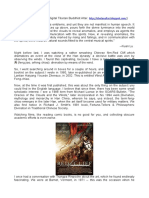Art Appreciation
Art Appreciation
Uploaded by
Arvee H. HolminaCopyright:
Available Formats
Art Appreciation
Art Appreciation
Uploaded by
Arvee H. HolminaOriginal Title
Copyright
Available Formats
Share this document
Did you find this document useful?
Is this content inappropriate?
Copyright:
Available Formats
Art Appreciation
Art Appreciation
Uploaded by
Arvee H. HolminaCopyright:
Available Formats
1. Prehistoric Art/Stone Age (40,000 B.C – 2300 B.
C)
The three-art form were cave painting, rock engraving and miniature figurative
carvings. Prehistoric Art to artifacts from ancient civilizations such as
Mesopotamia, Egypt, Greece and Rome wort was done with stone tools.
Hall of Bulls
2. Mesopotamian (3500 B.C – 539 B.C)
Warrior art and narration in stone belief.
Standard of UR
3. Egyptian (3100 B.C – 30 B.C)
Art with an afterlife focus, pyramids, and tomb painting
Bust of Nefertiti
4. Greek and Hellenistic (850 B.C – 31 B.C)
Greek idealism, balance, perfect proportions, and architectural orders (Doric,
Ionic, Corinthian)
Parthenon
5. Indian, Chinese, and Japanese (653 B.C – A.D 1900)
Serene, Meditatine art, and arts of floating world
Gu Kaizhi
6. Byzantine and Islamic (A.D 476 – A.D 1453)
Heavenly Byzantine Mosaics Islamic architecture and amazing maze-like design
7. Renaissance
Rebirth of classical culture and Monalisa
8. Baroque (1600 – 1750)
Splendor and flourish for God; Art as of weapon in the religious wars.
Massacre of the Innocents
9. Romanticism (1780 – 1850)
The triumph of imagination and individuality
Two Men Looking at the Moon
10. Realism (1840 – 1900)
Celebrating working class and Pleasants: En Plein Air Rustic Painting
11. Impressionism (1865 – 1885)
Capturing Fleeting Effects of Natural light
The Harvest
12. Post Impressionism
Post-Impressionist such as Vincent Van Gogh, continued to develop vivid colors,
dynamic brush work.
Starry Night
Greek and Hellenistic
Hellenistic art is the art of the Hellenistic period generally taken to
begin with the death of Alexander the Great in 323 BC and end with the
conquest of the Greek world by the Romans, a process well underway
by 146 BCE, when the Greek mainland was taken, and essentially
ending in 30 BCE with the conquest of Ptolemaic Egypt following the
Battle of Actium.
Prehistoric Art
Refers to the period prior to the existence of written history.
Throughout this time period, they worked using tools made of stone.
The three main art forms where cave paintings, rock engraving and
miniature figurative carvings
Egyptian (3100 B.C. – 30 B.C)
The ancient Egyptian civilization lasted over 3000 years and
demonstrated incredible continuity. Busts and statues of royal figures
were a major part of Egyptian art as well, which has many of its own
unique artistic periods. Egyptian art is a huge umbrella term for an
entire culture, after all. Ancient Egyptian art is the painting, sculpture,
architecture, and other arts produced by the civilization of ancient
Egypt in the lower Nile Valley from about 3000 BC to 30 B.C.
Indian, Chinese, and Japanese (653 B.C – A.D 1900)
Babur receives a courtier by Mirza Farrukh Baig (1589)
Admonitions of the court Instructress by Gu Kaizhi
The great wave of Kanagawa by Katsushika Hokusai (1829 – 1832)
Mesopotamian (3500 B.C – 539 B.C)
The Baroque period developed after the Renaissance and Mannerism art periods. It brought
with it new perspectives about life, art, religion, and culture. The Baroque style moved away
from the severe elements depicted by the Protestant style. The Catholic Church supported the
development of Baroque with its origins in Rome, Italy, and eventually in European countries
like northern Italy, France, Spain, Portugal, Austria, southern Germany, and Russia. Below, we
discuss this decorative and fanciful art period.
Baroque art of any kind was inseparably linked to the Catholic Church. In fact, the Church
informed what art should look like in order to have a desired effect upon the people. It was
made to inspire grandeur and awe in the people who experienced it and became a wholly new
sensory experience.
The term "post-Impressionism" was invented by the English painter and critic Roger Fry as he
prepared for an exhibition at the Grafton Gallery in London in 1910
The Post-Impressionists were an eclectic bunch of individuals, so there were no broad, unifying
characteristics. Each artist took an aspect of Impressionism and exaggerated it.
For example, during the Post-Impressionist movement, Vincent van Gogh intensified
Impressionism's already vibrant colors and painted them thickly on the canvas (a technique
known as impasto). Van Gogh's energetic brushstrokes expressed emotional qualities. While it
is difficult to characterize an artist as unique and unconventional as van Gogh, art historians
generally view his earlier works as representative of Impressionism, and his later works as
examples of Expressionism (art loaded with charged emotional content)
Renaissance
Rebirth of classical culture and Monalisa
Realism (1840 – 1900)
Celebrating working class and Pleasants
Byzantine and Islamic (A.D 476 – A.D 1453)
Heavenly Byzantine Mosaics Islamic architecture and amazing maze-like
design
Art Name: Hagai Sophia by Emperor Constantine
Impressionism (1865 – 1885)
Capturing Fleeting Effects of Natural light
Art Name: The Harvest by Vincent Van Gogh
You might also like
- Pino TRACKED REVISEDDocument7 pagesPino TRACKED REVISEDwenelyn pinoNo ratings yet
- Hempel Colour ChartDocument2 pagesHempel Colour Chartkhalid76471% (7)
- Art History Timeline: Art Periods/ Movements Characteristics Chief Artists and Major Works Historical EventsDocument2 pagesArt History Timeline: Art Periods/ Movements Characteristics Chief Artists and Major Works Historical EventsKirstieNicole100% (3)
- Creating The Divine Artist. From Dante To Michelangelo. EmisonDocument403 pagesCreating The Divine Artist. From Dante To Michelangelo. EmisonMark Eccles100% (4)
- Burns v. Town of Palm BeachDocument36 pagesBurns v. Town of Palm BeachCato InstituteNo ratings yet
- Art History TimelineDocument3 pagesArt History Timelinedurgisdurtan100% (1)
- Art History and DevelopmentDocument6 pagesArt History and DevelopmentSakuraNo ratings yet
- Western Art HistoryDocument47 pagesWestern Art Historyhengruh67% (3)
- Art History TimelineDocument67 pagesArt History TimelinePowerpuff GirlzNo ratings yet
- Art History TimelineDocument35 pagesArt History TimelineErlinda Marie MadridNo ratings yet
- What Are Arts and HumanitiesDocument9 pagesWhat Are Arts and HumanitiesAllison SwiftNo ratings yet
- ART Appreaciation: AssignmentDocument32 pagesART Appreaciation: AssignmentMainul IslamNo ratings yet
- Art History PDFDocument143 pagesArt History PDFREVEL100% (1)
- Art and HistoryDocument24 pagesArt and HistoryrandylyncabatuanNo ratings yet
- Art Appreciation Chapter 11. The Historical Development of ArtsDocument10 pagesArt Appreciation Chapter 11. The Historical Development of ArtsAlliah Mari Pelitro Baira0% (1)
- Lesson 2-WPS OfficeDocument11 pagesLesson 2-WPS OfficeKent MarianitoNo ratings yet
- ART Periods With NotesDocument34 pagesART Periods With Noteschlubomira231No ratings yet
- Chapter 7inart AppDocument10 pagesChapter 7inart Appaileenmanalo00No ratings yet
- Art Appreciation-EditedDocument34 pagesArt Appreciation-EditedRhea SalomonNo ratings yet
- Sculpture HistoryDocument14 pagesSculpture HistoryTikus FruyNo ratings yet
- Art HistoryDocument54 pagesArt Historycyrilcastillo123No ratings yet
- Art AppDocument5 pagesArt AppRIBO, DELNo ratings yet
- History of The ArtDocument2 pagesHistory of The ArtitsmezowiNo ratings yet
- Assignment HumanitiesDocument38 pagesAssignment HumanitiesKevin P. BacudNo ratings yet
- Lesson 3 Historical Foundation of ArtsDocument18 pagesLesson 3 Historical Foundation of ArtsGredanu LambaoNo ratings yet
- Individual PresentationDocument6 pagesIndividual PresentationPatricia ByunNo ratings yet
- The Greatest Civilization in The History of Ancient Art, Was The First Culture To Adopt A Recognizable Style of Art.Document4 pagesThe Greatest Civilization in The History of Ancient Art, Was The First Culture To Adopt A Recognizable Style of Art.Rheamar Angel MolinaNo ratings yet
- Chapter 10 Various Arts MovementsDocument11 pagesChapter 10 Various Arts MovementsestifhaniejeshorapaNo ratings yet
- Information-Sheet-Group 5Document14 pagesInformation-Sheet-Group 5shinamaevNo ratings yet
- Prehistoric ArtDocument2 pagesPrehistoric ArtZaleen BesinioNo ratings yet
- GartDocument17 pagesGartKarla Mae MarzanNo ratings yet
- Art HistoryDocument34 pagesArt HistoryJham PadillaNo ratings yet
- History of ArtDocument11 pagesHistory of ArtjhoenlitNo ratings yet
- Art HistoryDocument10 pagesArt HistoryYoj MilanaNo ratings yet
- Art Appreciation GEC 006Document4 pagesArt Appreciation GEC 006IanaCarandangNo ratings yet
- GROUP-9 - Historical Development of ArtDocument9 pagesGROUP-9 - Historical Development of ArtDianna Lynn MolinaNo ratings yet
- Prehistoric ArtDocument6 pagesPrehistoric Art601196No ratings yet
- Document (Project)Document10 pagesDocument (Project)Jen FinanceNo ratings yet
- Chapter 2 - Art HistoryDocument15 pagesChapter 2 - Art HistoryJiezl Mae PanaguitonNo ratings yet
- Name: Llapitan, Abegail V. Section: Bped-1A Gec 5 Topic 6 Activity 1Document4 pagesName: Llapitan, Abegail V. Section: Bped-1A Gec 5 Topic 6 Activity 1Christine LlapitanNo ratings yet
- Chapter 6-Art HistoryDocument16 pagesChapter 6-Art Historyklause SalamanNo ratings yet
- Written Output Group9Document17 pagesWritten Output Group9Dianna Lynn MolinaNo ratings yet
- Art History TimelineDocument34 pagesArt History Timelinemarry ann buccatNo ratings yet
- Italic Civilization Roman ArtDocument64 pagesItalic Civilization Roman ArtEman PalmaNo ratings yet
- Art Appreciation Module 7 Martinez Romnick Mel S.Document14 pagesArt Appreciation Module 7 Martinez Romnick Mel S.Kimmy MaklasNo ratings yet
- Project in Art Appreciation: Submitted By: Ralph C. OriendoDocument4 pagesProject in Art Appreciation: Submitted By: Ralph C. OriendoRalph CamoroNo ratings yet
- Week 9 Module (ArtAp)Document19 pagesWeek 9 Module (ArtAp)Michael NegrosNo ratings yet
- Surigao Del Norte State University: (Art Appreciation)Document6 pagesSurigao Del Norte State University: (Art Appreciation)smin61903No ratings yet
- Art App ReportDocument12 pagesArt App ReportAbdulhakim MautiNo ratings yet
- g5 Art of Emerging EuropeDocument32 pagesg5 Art of Emerging Europecute cuteNo ratings yet
- Different Periods of The Art HistoryDocument22 pagesDifferent Periods of The Art HistoryMark Arthur EscotoNo ratings yet
- Western and Eastern Art ConceptDocument17 pagesWestern and Eastern Art ConceptOwnzz Huda100% (1)
- Sculpture: San Juan, Baao, Camarines Sur Email Add: College of EducationDocument53 pagesSculpture: San Juan, Baao, Camarines Sur Email Add: College of EducationEarlie WritesNo ratings yet
- Art History Timeline 1Document40 pagesArt History Timeline 1yesha 11No ratings yet
- Art Appreciation FilesDocument42 pagesArt Appreciation FilesJaypee B. GranadilNo ratings yet
- Module 4 Art Movements (Art History) Part 1Document103 pagesModule 4 Art Movements (Art History) Part 1marasigan.michaelalouiseNo ratings yet
- Module 4 Art Movements (Art History) Part 1Document103 pagesModule 4 Art Movements (Art History) Part 1marasigan.michaelalouiseNo ratings yet
- Art TimelineDocument53 pagesArt TimelineAngelica SallanNo ratings yet
- 09 - Art MovementDocument13 pages09 - Art MovementVoxdeMacNo ratings yet
- Beige Vintage History of Cinema Timeline GraphDocument3 pagesBeige Vintage History of Cinema Timeline GraphKayezel SinohinNo ratings yet
- Arts ReviewerDocument5 pagesArts ReviewerKath ParNo ratings yet
- Art History TimelineDocument43 pagesArt History Timelinemark vincent santiagoNo ratings yet
- Greek Sculpture: A Collection of 16 Pictures of Greek Marbles (Illustrated)From EverandGreek Sculpture: A Collection of 16 Pictures of Greek Marbles (Illustrated)No ratings yet
- The Eternal Present, Volume II: The Beginnings of ArchitectureFrom EverandThe Eternal Present, Volume II: The Beginnings of ArchitectureNo ratings yet
- Mr. & Ms. Hermes ProgramDocument2 pagesMr. & Ms. Hermes ProgramArvee H. HolminaNo ratings yet
- Inflight Safety Demontration ScriptDocument2 pagesInflight Safety Demontration ScriptArvee H. Holmina0% (1)
- Heritage Landmarks QuestionnaireDocument1 pageHeritage Landmarks QuestionnaireArvee H. HolminaNo ratings yet
- Chapter 2 Project ManagementDocument5 pagesChapter 2 Project ManagementArvee H. HolminaNo ratings yet
- Chapter 1 E-Marketing (Research)Document3 pagesChapter 1 E-Marketing (Research)Arvee H. HolminaNo ratings yet
- AestheticismDocument11 pagesAestheticismemna2502No ratings yet
- Home Center PDFDocument118 pagesHome Center PDFzahmyNo ratings yet
- Kingsley Amis - Lucky Jim-Penguin Classics (2000)Document77 pagesKingsley Amis - Lucky Jim-Penguin Classics (2000)Lilly007No ratings yet
- Top 10 Clash of Clans Town Hall Level 7 Defense Base DesignDocument11 pagesTop 10 Clash of Clans Town Hall Level 7 Defense Base Designariffk10No ratings yet
- Contemporary Arts Module 2Document6 pagesContemporary Arts Module 2Jodel Novie LagareNo ratings yet
- Composition, Research and Pseudo-Science: A Response To John CroftDocument10 pagesComposition, Research and Pseudo-Science: A Response To John CroftYiorgos ChristofiNo ratings yet
- WT-Q2-Arts10-Wk2-5 (Module2)Document3 pagesWT-Q2-Arts10-Wk2-5 (Module2)Mary CrisNo ratings yet
- Chancery Job AidDocument1 pageChancery Job AidFamila Sujanee SampathNo ratings yet
- The Impact of English On Indian CultureDocument5 pagesThe Impact of English On Indian Cultureसंजय सानप100% (11)
- Terry, Arthur - Seventeenth-Century Spanish PoetryDocument316 pagesTerry, Arthur - Seventeenth-Century Spanish PoetryFabiánNo ratings yet
- Nimo TV LaunchingDocument21 pagesNimo TV LaunchingRyanNo ratings yet
- Before Qualcomm: Linkabit and The Origins of San Diego's Telecom IndustryDocument20 pagesBefore Qualcomm: Linkabit and The Origins of San Diego's Telecom Industryx2y2z2rm100% (1)
- 25 Hard Spelling Bee WordsDocument36 pages25 Hard Spelling Bee Wordsabu thanaaNo ratings yet
- Wind DivinationDocument14 pagesWind DivinationGiorgio MantelloNo ratings yet
- NAT REVIEW ON CPAR 25 ItemsDocument2 pagesNAT REVIEW ON CPAR 25 ItemsLOSILEN DONESNo ratings yet
- List of Books For Senior 2022 - 2023 SessionDocument6 pagesList of Books For Senior 2022 - 2023 SessiongossipstarnaijaNo ratings yet
- Architectural Association - November 2021Document2 pagesArchitectural Association - November 2021ArtdataNo ratings yet
- Piano Score, Violin Part, Concerto 2 WieniawskiDocument42 pagesPiano Score, Violin Part, Concerto 2 Wieniawskisapir chmelkinNo ratings yet
- The Death of The MothDocument20 pagesThe Death of The MothSitaNo ratings yet
- 100+ Stable Diffusion Styles & MediumsDocument63 pages100+ Stable Diffusion Styles & MediumsJuan-PabloChaperoArenas100% (2)
- Chapter 3 - Guide TonesDocument6 pagesChapter 3 - Guide TonesMario AvendañoNo ratings yet
- LS-3131 L3 Level PlanDocument1 pageLS-3131 L3 Level Planvin ssNo ratings yet
- 9.sınıf 1. Dönem 1. Yazılı 2022 ADocument2 pages9.sınıf 1. Dönem 1. Yazılı 2022 AduyguNo ratings yet
- Unseen Passages (Practice Paper 1) - XDocument4 pagesUnseen Passages (Practice Paper 1) - Xdharam14285759No ratings yet
- Passive Voice: Guernica Was Painted by Miró. (Picasso)Document1 pagePassive Voice: Guernica Was Painted by Miró. (Picasso)Carlos IrigoyenNo ratings yet
- Opening The Cultural Criminology PDFDocument16 pagesOpening The Cultural Criminology PDFLeandro Sant.No ratings yet






























































































